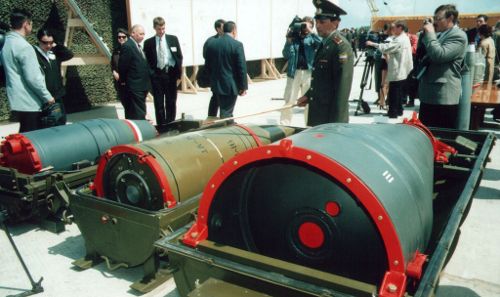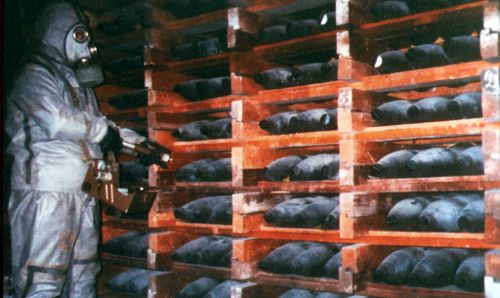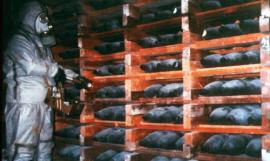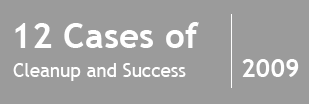Disarming And Destroying Chemical Weapons
| Location | Global |
|---|---|
| Pollutant | Chemicals including chlorine, sulfur mustard, hydrogen cyanide, and sarin |
| Cause | Chemical weapons |
| Population Affected | Global |
| Health Impact | Weaponized chemicals are designed for use in warfare to cause death. |
| Output | Chemical Weapons Convention (CWC) was approved by the United Nations General Assembly in 1992 and ultimately ratified by 188 countries, effectively curtailing nearly all production and use of chemical weapons worldwide. Since 1995 Green Cross/Global Green have actively supported destruction of chemical weapons stockpiles in Russia and the US through a network of public outreach offices and educational activities. |
| Outcome | Destruction programs are ongoing in all seven possessor states, including the two main possessor states, the U.S. and the Russian Federation. |
| Implications | By 2021, all chemical weapons in the world should be destroyed. Regular inspections of chemical industry as foreseen in the CWC prevents clandestine reproduction of chemical weapons. Countries that are not members of the CWC are excluded from global chemical trade. |
| Remaining Challenges | Three primary challenges remain: the safe destruction of remaining stockpiles, the identification and disposal of improperly discarded chemicals, and the acceptance of the treaty among the few remaining countries outside of the treaty. |
Context
Old and abandoned chemical weapons (OCW/ACW) stockpiles can be found in nearly every country that produced or stored chemical weapons or where chemical weapons were deployed during war, as mentioned in the 2008 World’s Worst Polluted Places Report. The most common methods of OCW disposal historically have been ocean dumping, burial or open-air incineration. During the large weapons destruction campaigns after WWII, hundreds of thousands of tons of OCW were transported to the nearest ocean port, loaded on boats and then dumped into the sea. Weapons not suitable for long-distance transport were often buried (resulting over time in leaking of the shells due to long-term corrosion) or burned in open pits, or the chemical agent was poured into lakes. As a result, traces of undestroyed chemical agent or products of its destruction (dioxines, furanes, arsenic, acids, etc.) are leaching today at these sites into the surrounding environment. Buried shells are often discovered by chance (e.g. during construction projects), the long-term corrosion making identification of the contents difficult and the shells dangerous to handle.
While the destruction of military deployable chemical weapons is occurring globally under the auspices of the Chemical Weapons Convention, OCW/ACW remain a difficult issue. A major challenge is that almost no archive data exists about the location of OCW/ACW sites and most findings are chance discoveries. The number of OCW/ACW sites is not well known. The locations of OCW/ACW types and sites have been as diverse as unexploded shells on WWI battlefields in Europe, shells sunk in Japanese ports, Japanese shells left in Northern China, or shells incinerated or buried in Russia and the U.S. Numbers can also vary from a few shells up to burial sites with thousands of shells. The U.S. Army has defined more than 200 sites with OCW in the U.S. In Russia, experts estimate the existence of some dozens of OCW sites.
Site Details
Chemical weapons are classified as arms that use toxic chemical substances to harm or kill an enemy during warfare. According to the International Chemical Weapons Convention, there are over 50 different chemicals that have been produced specifically for use as weapons during warfare (also known as “chemical weapons agents” or CWA). Most chemical weapons produced have either been used on the battlefields of WWI (more than hundred thousand about 124,000 metric tons), dumped in one of the many oceans during the 50’s and 60’s (several hundred thousand metric tons) or were still stored Chemical nuclear warheads at a Russian stockpile
in stockpiles worldwide up until the 1990s (about 70,000 metric tons). By summer 2009, roughly half of this amount has been destroyed. These remaining stockpiles are extremely dangerous if they are not adequately maintained and guarded.
Exposure Pathways
Chemical weapon agents or products of their unregulated destruction (open-air incineration, sea-dumping, burial) like dioxins and furan reaction masses from open-pit burning or dumping are highly toxic. Besides direct exposure, the main risk is the migration of these substances into the ground and drinking water, where they quickly bioaccumulate in the food chain.
A Dead Lake For Drinking Water?
The dumping of phosgene, diphosgen and picric acid in Lake Mokhovoe in Russia’s Penza region released approximately 740 tons of hydrochloric acid into the lake of 300’000m3. The water in the 1960s showed an extremely low pH-level of 1.5-2.5, killing every plant and animal in the lake. Although the lake has recovered a bit in the intervening decades, it remains at an unusually low pH-level of 4.2-4.8. As a result of the acidity of the water, there are still only a few primitive life forms found in the lake today. This lake is one of the only source of drinking water for the more than 650,000 inhabitants of Penza (Surskoe water reserve).
Health Impact
According to the Organization for the Prohibition of Chemical Weapons, chemical agents fall into four general categories:
- Choking Agents such as chlorine, phosgene, diphosgene and chloropicrin, are absorbed through the lungs and cause the build up of fluids, which leads to choking and eventual death.
- Blister Agents such as sulfur mustard, nitrogen mustard, and lewisite burn the skin, mucous membranes and eyes, causing large blisters on exposed skin. When inhaled as a vapor, these agents can burn the windpipe and lungs, leading to death.
- Blood Agents such as hydrogen cyanide, cyanogen chloride and arsine, prevent blood and tissue cells from accepting oxygen, causing rapid organ failure.
- Nerve Agents such as tabun, sarin, soman, and VX, cause paralysis of muscles (including the heart and diaphragm), seizures and loss of body control. This is the most deadly group of warfare agent, amounts the size of a small drop lethal doses can cause almost immediate death.
Intervention
The Chemical Weapons Convention (CWC) is an international treaty specifically aimed at eliminating military-deployable chemical weapons through prohibiting “the development, production, acquisition, stockpiling, transfer, and use of chemical weapons”. As of August 2009, there were 188 member states (out of 195 countries), and four countries with declared Chemical Weapon (CW) stockpiles.
Green Cross Switzerland, with its partner organizations Green Cross Russia and Global Green USA, has been key in facilitating the timely and safe destruction of CWs in Russia and the U.S., which together possess more than 90 percent of global CW stockpiles. In 2000, Green Cross Switzerland launched “Destroy Chemical Weapons Now,” an international information campaign intended to raise awareness of the approximate 70,000 tons of toxic chemical weapons that still existed throughout the world at that time. The organization has also encouraged an international partnership toward global chemical disarmament, and effective implementation of the Chemical Weapons Convention. Starting in 1997, Green Cross/Global Green has established a network of 12 local/regional public information and outreach offices in Russia and initiated an annual National Dialogue meeting which brings together all stakeholders. Since 2007, Green Cross has been working with Blacksmith Institute to isolate three open pit burning sites in Russia’s Penza region that threaten the drinking water supply of 600,000 people through the migration of dioxines, furanes and arsenic released during the incineration process into Penza’s drinking water reserve.
Implementing Organizations
Green Cross Switzerland, Green Cross Russia, Global Green USA, and Blacksmith Institute
Remaining Challenges
Safe destruction of remaining chemical weapon stockpiles demands labor- and capital-intensive processes. Currently, there is no international inventory or exhaustive data on the quantity or location of these chemicals, causing a security issue around the world. In order to completely remove remaining weapons, the international political community must reach consensus and act upon this issue collectively.
Additional Photos
 |
|
| Chemical nuclear warheads at a Russian stockpile | |
 |
|
| Russian stockpile with chemical artillery shells. These weapons are inspected regularly. Chemical test kits help to rule out the presence of warfare agent vapour in air from leaking weapons. This stockpile is in the process of being destroyed since May 2009. |

-
Phasing Out Leaded Gasoline
-
Ending Chemical Weapons
-
Improving Indoor Air - Ghana
-
Preventing Mining Pollution - Chile
-
Lowering Radioactivity - Chernobyl
-
Cleaning Urban Air - India
-
Removing Lead - Dom. Republic
-
Recapturing Mercury - Indonesia
-
Reducing Lead - Russia
-
Removing DDT - Tanzania
-
Restoring a Waterway - China
-
Removing Arsenic - India



